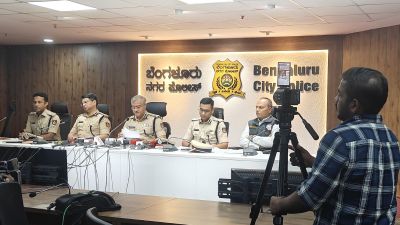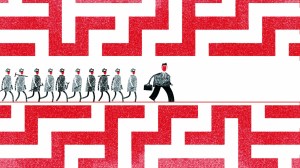Priya Kumari Shukla is a Senior Copy Editor in the Indian Express (digital). She contributes to the UPSC Section of Indian Express (digital) and started niche initiatives such as UPSC Key, UPSC Ethics Simplified, and The 360° UPSC Debate. The UPSC Key aims to assist students and aspirants in their preparation for the Civil Services and other competitive examinations. It provides valuable guidance on effective strategies for reading and comprehending newspaper content. The 360° UPSC Debate tackles a topic from all perspectives after sorting through various publications. The chosen framework for the discussion is structured in a manner that encompasses both the arguments in favour and against the topic, ensuring comprehensive coverage of many perspectives. Prior to her involvement with the Indian Express, she had affiliations with a non-governmental organisation (NGO) as well as several coaching and edutech enterprises. In her prior professional experience, she was responsible for creating and refining material in various domains, including article composition and voiceover video production. She has written in-house books on many subjects, including modern India, ancient Indian history, internal security, international relations, and the Indian economy. She has more than eight years of expertise in the field of content writing. Priya holds a Master's degree in Electronic Science from the University of Pune as well as an Executive Programme in Public Policy and Management (EPPPM) from the esteemed Indian Institute of Management Calcutta, widely recognised as one of the most prestigious business schools in India. She is also an alumni of Jamia Milia Islamia University Residential Coaching Academy (RCA). Priya has made diligent efforts to engage in research endeavours, acquiring the necessary skills to effectively examine and synthesise facts and empirical evidence prior to presenting their perspective. Priya demonstrates a strong passion for reading, particularly in the genres of classical Hindi, English, Maithili, and Marathi novels and novellas. Additionally, she possessed the distinction of being a cricket player at the national level. Qualification, Degrees / other achievements: Master's degree in Electronic Science from University of Pune and Executive Programme in Public Policy and Management (EPPPM) from Indian Institute of Management Calcutta ... Read More
UPSC Key-4 July, 2023: What you should read in the news today
Exclusive for Subscribers from Monday to Friday: Have you ever thought about how the Article 370 of the Indian Constitution or Nirbhaya Fund are relevant to the UPSC Exam? What significance do topics like National Sickle Cell Anaemia Elimination Mission (NSCEM) or Deep-sea mining have for both the preliminary and main exams? You can learn more by reading the Indian Express UPSC Key for July 4, 2023.
 UPSC Key July 2023: Here's what you should be reading from the July 4, 2023 edition of The Indian Express.
UPSC Key July 2023: Here's what you should be reading from the July 4, 2023 edition of The Indian Express.
Important topics and their relevance in UPSC CSE exam for July 4, 2023. If you missed the July 3, 2023 UPSC key from the Indian Express, read it here
FRONT PAGE
As House panel meets on UCC, chief Sushil Modi questions feasibility in tribal areas
Syllabus:
Preliminary Examination: Indian Polity and Governance
Main Examination:
• General Studies II: Indian Constitution—significant provisions etc.
• General Studies II: Government policies and interventions for development in various sectors and issues arising out of their design and implementation.
Key Points to Ponder:
• What’s the ongoing story- Amid a debate on the proposed Uniform Civil Code, triggered by the Law Commission’s decision to examine the issue afresh and Prime Minister Narendra Modi’s subsequent remarks on the matter, BJP MP Sushil Kumar Modi, Chairman of the Parliamentary Standing Committee on Law, is learnt to have questioned the feasibility of a UCC in tribal areas, including those in the North East, since their customs, traditions and rituals are different from other communities and the Constitution grants them protection.
• Uniform Civil Code-What’s the debate exactly?
• What has the 22nd Law Commission of India said regarding the Uniform Civil Code?
• ‘BJP MP Sushil Kumar Modi, Chairman of the Parliamentary Standing Committee on Law, is learnt to have questioned the feasibility of a UCC in tribal areas’-What’s your take?
• ‘In 2016, when the Law Commission of India sought the opinion of people on UCC, the Rashtriya Adivasi Ekta Parishad filed a petition in the Supreme Court seeking its intervention to protect the customary rights of Adivasis’-What do understand by customary rights of Adivasis?
• What are arguments for implementing Uniform Civil Code in India?
• What are arguments against implementing Uniform Civil Code in India?
• What constitutional experts saying in this regard?
• “Uniform Civil Code that will applicable throughout the territory of India”-Do you think the implementation will adversely impact India’s Diversity?
• “Unity in Diversity” and “Uniform Civil Code”-connect the dots
Other Important Articles Covering the same topic:
SC to hear petitions challenging changes to Article 370 on July 11
Syllabus:
Preliminary Examination: Indian Polity and Governance-Constitution, Political System, Panchayati Raj, Public Policy, Rights Issues, etc.
Mains Examination: General Studies II: Indian Constitution—historical underpinnings, evolution, features, amendments, significant provisions and basic structure.
Key Points to Ponder:
• What’s the ongoing story-A FIVE-JUDGE Supreme Court Bench presided by Chief Justice of India D Y Chandrachud will take up on July 11 petitions challenging the changes to Article 370 of the Constitution, which granted special status to Jammu and Kashmir. According to a notification issued by apex court on Monday, the Bench, which also comprises Justices S K Kaul, Sanjiv Khanna, B R Gavai and Surya Kant, will take up the petitions “for directions”. The pleas also challenge the reconstitution of the former state of Jammu and Kashmir into the Union territories of Jammu and Kashmir and Ladakh.
• Article 370 of the Indian Constitution-What you about this article?
• How was Article 370 enacted?
• Was Article 370 a temporary provision?
• What specific aspect of Article 370 has been contested before the Supreme Court?
• For Your Information-Petitions challenging the August 2019 decision of the Union government last came up in the Supreme Court on March 2, 2020, when a five-judge bench presided by Justice N V Ramana rejected the prayer to refer the petitions to a larger Bench. The court, however, made it clear that its order “is confined to the limited preliminary issue of whether the matter should be referred to a larger Bench” and “have not considered any issue on the merits of the dispute”. The other members on the Bench were Justices Sanjay Kishan Kaul, R Subhash Reddy, B R Gavai and Surya Kant. Justice Reddy retired in January last year and Justice Ramana retired as Chief Justice of India in August 2022. There are as many as 23 petitions relating to the issue pending before the court. They challenge the Presidential orders of August 5 and 6, 2019 as well as The Jammu and Kashmir Reorganisation Act, 2019. The petitions challenge the Presidential Orders of August 5–6, 2019, as well as The Jammu and Kashmir Reorganisation Act, 2019. The August 5 order titled Constitution (Application to Jammu and Kashmir) Order, 2019, was passed in exercise of the power under Article 370(1)(d) of the Constitution, superseding the 1954 Presidential Order that introduced Article 35A, which empowered the state of J&K to define who is a permanent resident and make special laws for them.
Other Important Articles Covering the same topic:
📍SC to hear pleas against abrogation of Article 370: Here’s what you need to know
📍Explained: What are Articles 370 and 35A?
📍Explained: What’s changed in Jammu and Kashmir?
EXPRESS NETWORK
Govt launches scheme for shelter, aid to pregnant minor rape victims
Syllabus:
Preliminary Examination: Indian Polity and Governance-Constitution, Political System, Panchayati Raj, Public Policy, Rights Issues, etc.
Mains Examination:
• General Studies I: Social empowerment
• General Studies II: Welfare schemes for vulnerable sections of the population by the Centre and States and the performance of these schemes; mechanisms, laws, institutions and Bodies constituted for the protection and betterment of these vulnerable sections.
Key Points to Ponder:
• What’s the ongoing story- Union Minister for Women and Child Development Smriti Irani on Monday launched a scheme to provide shelter, food and legal aid for pregnant minor victims of sexual assault who have no family support. The proposal for “critical care and support for accessing justice to rape/gang rape survivors and minor girls who get pregnant” has been approved by the WCD Ministry with an outlay of Rs 74.10 crore and will be applicable across the country in a week’s time, the ministry officials said.
• What has been Proposed?
• For Your Information-The scheme aims to provide shelter, food, daily needs, safe transportation for attending court hearings and legal aid to minor girls who have been abandoned by their family due to forced pregnancy, either due to rape or gang rape, or due to any other reason, and have no other means to support themselves. In 2021, the National Crime Records Bureau (NCRB) reported 51,863 cases under the POCSO Act. The WCD Ministry officials revealed that 64% or 33,348 cases out of those were reported under sections 3 and 5 of the Act, which pertains to penetrative sexual assault and aggravated penetrative sexual assault, respectively. According to officials, the fund will help in setting up shelters for such victims. This could be in the nature of standalone shelters, or wards earmarked for such victims in existing child care institutions (CCIs), as state governments see fit. In case of wards inside existing CCIs, the person in-charge of the institution will ensure that a separate safe space is provided to minor rape victims, “as her needs may be different from other children residing there’’. This will ensure integrated support and assistance to minor victims under one roof, said the ministry officials.
• What is the Nirbhaya Fund?
• What is the amount of Nirbhaya Fund?
• What is Nirbhaya Scheme?
• For Your Information- As per PIB, The Government of India had set up a dedicated fund called ‘Nirbhaya Fund’ for implementation of initiatives aimed at enhancing the safety and security for women in the country. Under the Nirbhaya Fund, one of the schemes namely “One Stop Centre (OSC) Scheme” is implemented across the country since 1st April 2015. OSCs aim to facilitate women affected by violence with a range of integrated services under one roof such as Police facilitation, medical aid, providing legal and psycho-social counselling and temporary shelter. OSCs are to be set up within 2 kms radius of the hospitals or medical facilities either in new constructed building in an approved design or in pre-existing buildings. Under the scheme, One Stop Centres are being set up in all districts of the country.
• What is the Mission Vatsalya Scheme?
• What are Child Care institutions [CCIs]?
Other Important Articles Covering the same topic:
📍Centre releases child protection scheme guidelines, asks states to not tamper with name
📍10 years since Dec 16 gangrape shook nation, just half of funds for women’s safety utilised
THE IDEAS PAGE
Syllabus:
Preliminary Examination: Current events of national and international importance.
Mains Examination: General Studies II: Government policies and interventions for development in various sectors and issues arising out of their design and implementation.
Key Points to Ponder:
• What’s the ongoing story-Partha P Majumder Writes: On June 28, the Union Cabinet approved the National Research Foundation (NRF) Bill in Parliament. The NRF will be an apex body to provide high-level strategic direction to scientific research in India, aligning with the recommendations of the National Education Policy (NEP), 2023. The Science and Engineering Research Board (SERB), created by an act of Parliament in 2008, will stand repealed and subsumed into the NRF.
• What is National Research Foundation?
• What is the purpose of National research Foundation?
• What is the aim of National Research Foundation?
• The administrative department of the NRF will be managed by whom?
• The governance of NRF will be formulated by a Governing Board, presided by whom?
• The principal reason to form the NRF is what?
• For Your Information-The principal reason to form the NRF is to foster collaboration among academic and research institutions, industry and government departments. The NRF will create a policy framework and regulatory processes that can encourage collaboration and increased spending by industry on research and development. Apparently, a Bill needed to be introduced because current laws do not easily permit a private organisation to contribute funds for research to a body, such as the NRF. The NRF will play a pivotal role in seeding, nurturing and promoting research, innovation and development across universities, colleges, research institutions, and R&D laboratories. It will create an interface mechanism so that, in addition to the scientific and line ministries, the state governments and industries can also participate and contribute to scientific R&D.
• How much does India barely spend on research and development?
• Do You Know-India barely spends 0.7 per cent of its GDP on research and development, which is extremely low compared to many other countries. In fact, the gross expenditure on R&D declined from 0.84 per cent in 2008 to about 0.69 per cent in 2018, the last year for which confirmed figures are available. In comparison, the US spent 2.83 per cent, China spent 2.14 per cent, and Israel spent 4.9 per cent. Even Brazil, Malaysia and Egypt spend more of their GDP on research. The proposal for an NRF was first floated in the public domain by Prime Minister Narendra Modi on January 3, 2019 during his address to the Indian Science Congress. The NRF found a second mention on January 20 that year during a joint session of Parliament, and then later in the Finance Minister’s speech during the Budget Session in July 2019. The creation of NRF was also one of the key recommendations of the National Education Policy 2020.
• What is Prime Minister’s Science Technology and Innovation Advisory Council (PM-STIAC)?
• What are the loopholes in National Research Foundation?
• For Your Information- The NRF is also expected to promote democratisation of science funding and, funding to find scientific solutions to some big problems facing our society. These are welcome moves. However, it is important to ensure that basic research and small-scale research proposals are not brushed aside. Modalities of seeding, nurturing and promoting research by providing funds to less-endowed institutions and also monitoring outcomes should be transparent. A significant problem that the scientists have been facing is that proposed scientific projects are reviewed and sanctioned, but fund-release is often choppy. And, it has been choppy for many years. Projects that are sanctioned for funding for three years often do not receive the third year’s funds. The reasons underlying choppy fund-release must be thoroughly investigated and correctional steps must be implemented. Else, the delivery promises made in a project proposal will often remain undelivered, and the NRF will not be impactful on the science landscape of our country.
Other Important Articles Covering the same topic:
📍What is National Research Foundation?
Syllabus:
Preliminary Examination: Economic and Social Development
Mains Examination: General Studies II: Issues relating to development and management of Social Sector/Services relating to Health, Education, Human Resources.
Key Points to Ponder:
• What’s the ongoing story- Mansukh Mandaviya Writes: The government has allocated a sufficient budget, utilised advanced technology, provided training to healthcare workers, ensured necessary infrastructure, and made efforts in social awareness and participation to combat this disease. These endeavours are the result of strong determination and policy decisions
• ‘Sickle cell disease is a serious health challenge in India’s tribal population’-Discuss
• For Your Information-In India, there are approximately 706 different tribal communities, which constitute 8.6 per cent of the total population. Our tribal population is an integral part of our country’s rich cultural heritage. PM Modi has said, “the past, present, and future of India will never be complete without the indigenous communities.” The Government of India is fully committed to the health and development of the tribal population as a national priority, taking into account their ethical values, traditions, socio-economic conditions, and tribal organisations.
• What is Sickle cell disease?
• What is sickle cell anaemia?
• Do You Know-Sickle cell anaemia is a genetic disorder in which red blood cells become oval shaped due to oxygen deficiency. The World Health Organization (WHO) states that Africa has the highest burden of sickle cell anaemia. According to the Centre, India has the second-highest burden of this condition in the world. An estimated 30,000-40,000 children born every year suffer from this disorder. The condition is especially widespread among India’s tribal population, where one in 86 infants suffers from this condition. Of the 15 states that share the highest incidence of this disease, Maharashtra tops the chart.
• What is the burden of disease?
• Why is Sickle Cell anaemia so under-diagnosed and how can it be prevented?
• Why this disease is commonly found among tribal communities?
• For Your Information-Prime Minister of India, Narendra Modi launched the National Sickle Cell Anaemia Elimination Mission (NSCEM) in Shahdol, Madhya Pradesh on 1st July 2023. The National Sickle Cell Anaemia Elimination Program, introduced in the Union Budget 2023, focuses on addressing the significant health challenges posed by sickle cell disease, particularly among tribal populations of the country. Sickle cell disease (SCD) is a chronic single gene disorder causing a debilitating systemic syndrome characterized by chronic anemia, acute painful episodes, organ infarction and chronic organ damage and by a significant reduction in life expectancy. Implemented in 17 high-focus states across the country, this program aims to improve the care and prospects of all sickle cell disease patients while reducing the prevalence of the disease. The 17 states are- Gujarat, Maharashtra, Rajasthan, Madhya Pradesh, Jharkhand, Chhattisgarh, West Bengal, Odisha, Tamil Nadu, Telangana, Andhra Pradesh, Karnataka, Assam, Uttar Pradesh, Kerala, Bihar, and Uttarakhand. The program is executed in a mission mode as part of the National Health Mission (NHM), aims to eliminate sickle cell genetic transmission by the year 2047, showing a long-term commitment to eradicating the disease. Over a period of three years, spanning from the fiscal year 2023-24 to 2025-26, the program targets screening approximately 7.0 crore people. This ambitious goal highlights the program’s dedication to reaching a large portion of the population, promoting early diagnosis and intervention.
• What is Ayushman Bharat scheme for?
• Ayushman Bharat Scheme-Key Highlights
• India’s Health Budget-Know the Statistics
• Public Health Systems in India-Know the Background
• Current state of India’s health infrastructure- What World Bank data says?
Other Important Articles Covering the same topic:
📍Mission to combat sickle cell anaemia
📍Prime Minister launches National Sickle Cell Anaemia Elimination Mission from Shahdol, Madhya Pradesh
EXPLAINED
Syllabus:
Preliminary Examination: Current events of national and international importance.
Mains Examination: General Studies II: Bilateral, regional and global groupings and agreements involving India and/or affecting India’s Interests.
Key Points to Ponder:
• What’s the ongoing story- The Russia-Ukraine war is also likely to be discussed as Russian President Putin will be attending the summit, days after a failed armed mutiny by a Russian mercenary group. Putin spoke to Modi last week about the mutiny, and had claimed the Indian Prime Minister’s support. In the last SCO summit that took place in-person in Samarkand, Uzbekistan in September last year, Modi had told Putin that this is not the era of war. The meeting is also being held in the context of the border standoff between Indian and Chinese troops, and Chinese President Xi’s presence will be watched closely, as issues of respect for territorial integrity and sovereignty are expected to come up. India’s association with the SCO began in 2005 as an Observer country. India became a full Member State of SCO at the Astana Summit in 2017, which was a “historic moment” in India’s engagement with the Organisation, according to officials.
• What is Shanghai Cooperation Organisation?
• What kind of a grouping is the Shanghai Cooperation Organisation?
• Know the members and observer countries in Shanghai Cooperation Organisation
• Map Work-Mark Shanghai Cooperation Organisation member countries with their capital
• Is India a part of Shanghai Cooperation Organisation?
• When did India become permanent member of the Shanghai Cooperation Organisation?
• What is the importance of the Shanghai Cooperation Organisation for India?
• India is hosting the SCO meeting, which Putin is expected to attend, as the Russia-Ukraine war drags on. What is the significance of the meeting at such a time?
• At the last SCO meeting in Samarkand, PM Modi had told Putin “this is not the era of war”. What impact would you say the statement has had? What is the way ahead?
• Xi is likely to participate in this meeting, three years after the Galwan clash and months ahead of his visit to India for the G20 summit. Could this meeting have any bearing on either of these two things?
• Pak PM Sharif is likely to participate in the meeting. At the SCO foreign ministers’ meet in Goa, India had taken a hard line on cross-border terrorism. Is the issue likely to feature in a big way again?
• The Central Asian countries have traditionally been considered Russia’s backyard. But now, China is trying to expand its footprint in the region. How do you see them responding to this battle of influence between Moscow and Beijing?
• Could you elaborate on how the elites may not have a problem with China, but the common man in these countries does?
• In the SCO meets over the years, what distance has India come in achieving its key goals, and what do you think can be the reasonable expectations from today’s summit?
• Under what circumstances did India enter the Shanghai Cooperation Organisation?
• How does membership of the Shanghai Cooperation Organisation help India?
• How does global geopolitics play out for Shanghai Cooperation Organisation and India?
• How does it play out in the India-Pakistan or India-China relationship?
Other Important Articles Covering the same topic:
📍SCO meets today; terror, territorial integrity on agenda
📍What is the Shanghai Cooperation Organisation Summit?
📍Explained: What SCO summit means for India’s global and regional interests
Syllabus:
Preliminary Examination: Current events of national and international importance.
Mains Examination: General Studies II: Important International institutions, agencies and fora- their structure, mandate.
Key Points to Ponder:
• What’s the ongoing story- The International Seabed Authority — the United Nations body that regulates the world’s ocean floor — is preparing to resume negotiations that could open the international seabed for mining, including for materials critical for the green energy transition. Years long negotiations are reaching a critical point where the authority will soon need to begin accepting mining permit applications, adding to worries over the potential impacts on sparsely researched marine ecosystems and habitats of the deep sea.
• What is deep-sea mining?
• How is Deep Sea Mining regulated now?
• For Your Information-Countries manage their own maritime territory and exclusive economic zones, while the high seas and the international ocean floor are governed by the United Nations Convention on the Law of the Seas. It is considered to apply to states regardless of whether or not they have signed or ratified it. Under the treaty, the seabed and its mineral resources are considered the “common heritage of mankind” that must be managed in a way that protects the interests of humanity through the sharing of economic benefits, support for marine scientific research, and protecting marine environments. Mining companies interested in deep sea exploitation are partnering with countries to help them get exploration licenses. More than 30 exploration licenses have been issued so far, with activity mostly focused in an area called the Clarion-Clipperton Fracture Zone, which spans 1.7 million square miles (4.5 million square kilometers) between Hawaii and Mexico.
• Why is there pressure on the ISA to establish regulations now?
• What are the environmental concerns?
Other Important Articles Covering the same topic:
📍Deep-sea mining
Annoying pop-ups you can’t get rid of: why Govt is going after ‘dark patterns’
Syllabus:
Preliminary Examination: Current events of national and international importance.
Mains Examination: General Studies II: Government policies and interventions for development in various sectors and issues arising out of their design and implementation.
Key Points to Ponder:
• What’s the ongoing story- The Centre has asked e-commerce companies to not use “dark patterns” on their platforms that may deceive customers or manipulate their choices. The government has set up a 17-member task force to prepare guidelines to protect consumers. The Ministry of Consumer Affairs, Food and Public Distribution consulted stakeholders on this issue on June 13. Consumer Affairs Secretary Rohit Kumar wrote to major e-commerce platforms on June 28. The Ministry has started classifying complaints received on the National Consumer Helpline 1915 to compile information on dark patterns, which can be used by the Central Consumer Protection Authority to initiate action under the Consumer Protection Act, 2019.
• What are dark patterns?
• What is Central Consumer Protection Authority?
• How to spot dark patterns?
• What are other governments doing?
Other Important Articles Covering the same topic:
📍Explained: Govt to establish Central Consumer Protection Authority; what is it?
For any queries and feedback, contact priya.shukla@indianexpress.com
The Indian Express UPSC Hub is now on Telegram. Click here to join our channel and stay updated with the latest Updates.
UPSC Magazine

Read UPSC Magazine



- 01
- 02
- 03
- 04
- 05





























